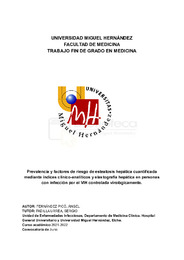Resumen :
La esteatosis hepática (EH) es una enfermedad cuya prevalencia está en aumento y que está muy
ligada a la epidemia global que supone la obesidad y el síndrome metabólico. Con el avance de las
terapias antirretrovirales (ART), se ha descrito en los últimos años un aumento de la prevalencia de
EH en personas con infección por VIH. Sin embargo, no se utilizan métodos de estimación de grasa
hepática en el seguimiento de estos pacientes.
Objetivo: Estimar la prevalencia de EH, usando métodos directos e indirectos, en personas con
infección por VIH, y determinar factores de riesgo y predictores.
Métodos: Se trata de un estudio observacional transversal en población en seguimiento por infección
por el VIH en la UEI del HGUE. Se realizó un análisis de prevalencia de EH mediante índices
clínico-analíticos (considerando EH como HSI ≥ 36) con datos provenientes de la base de datos
clínicos y analíticos asociada (Software ACyHⓇ), y un análisis comparativo de prevalencia de EH
mediante elastografía hepática (considerando EH como CAP ≥ 263 dB/m) entre un grupo VIH y un
grupo Control.
Resultados: Se incluyeron 485 pacientes en el análisis de índices clínico-analiticos y 59 pacientes
en el análisis comparativo mediante elastografía hepática. La prevalencia de EH en sujetos con
infección por VIH medida mediante el índice HSI fue del 35,86% y en en el grupo VIH medido
mediante FibroscanⓇ fue del 41,03%. Mayores niveles de IMC [OR (IC95%); 1,33 (1,028 - 1,727)],
perímetro abdominal, triglicéridos, glucosa, HTA [OR (IC95%); 1,81 (1,111 - 2,977)], DM y resistencia
insulínica [OR (IC95%); 1,81 (1,421 - 4,294)) se asociaron con EH, mientras que los parámetros
inmuno-virológicos no mostraron asociación. Los índices HSI y FLI mostraron una correlación
significativa (p-valor < 0,001) y moderada (0,583 y 0,664 respectivamente) con el CAP.
Conclusiones: Existe una prevalencia significativa de EH en personas con infección por VIH. El
síndrome metabólico es un factor determinante en su desarrollo, aunque se sugiere que exista un
mecanismo fisiopatológico subyacente provocado por el VIH. Existen una serie de índices
clínico-analíticos que constituyen una herramienta sencilla y práctica para estratificar el riesgo de EH
en estos pacientes.
Liver steatosis (LS) prevalence is increasing and it is closely associated with global epidemic of
obesity and metabolic syndrome. With the development of antiretroviral therapies (ART), an increase
in the LS prevalence in HIV-infected patients has been described in recent years. However, liver fat
estimating methods are not used in the follow-up of these patients.
Objective: To estimate the LS prevalence, using direct and indirect methods, in HIV-infected patients,
and to determine risk factors and predictors.
Methods: This is a cross-sectional study. We included HIV-infected patients followed-up by the
HGUE’s UEI service. First, LS prevalence analysis was performed using clinical-analytical indexes
(considering LS as HSI ≥ 36) with data from the associated clinical and analytical database (Software
ACyH(R)). Another LS prevalence comparative analysis, using transient elastography (considering LS
as CAP ≥ 263 dB/m), was performed between HIV-infected patients and a control group.
Results: 485 patients were included in the clinical-analytical indexes analysis and 59 patients were
included in the transient elastography comparative analysis. The prevalence of LS in subjects with
HIV infection measured by the HSI index was 35.86%. The prevalence of LS in the HIV group
measured by Fibroscan(R) was 41.03%. Higher levels of BMI [OR (IC95%); 1,33 (1,028 - 1,727)],
waist circumference, triglycerides, glucose, hypertension [OR (IC95%); 1,81 (1,111 - 2,977)], diabetes
and insulin resistance [OR (IC95%); 1,81 (1,421 - 4,294)] were associated with HD, whereas HIV
immuno-virological parameters showed no association. HSI and FLI indexes showed a significant
(p-value < 0.001) and moderate correlation (0.583 and 0.664 respectively) with the CAP.
Conclusions: There is a significant prevalence of LS in people living with HIV infection. Metabolic
syndrome is a determining factor in its development, although it is suggested that there is an
underlying pathophysiological mechanism caused by HIV. There are some clinical-analytical indexes
that constitute a simple and practical tool to stratify the risk of LS in these patients.
|
 La licencia se describe como: Atribución-NonComercial-NoDerivada 4.0 Internacional.
La licencia se describe como: Atribución-NonComercial-NoDerivada 4.0 Internacional.
.png)
